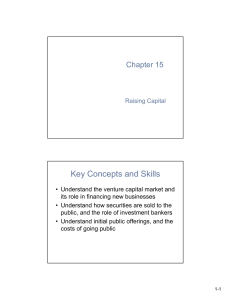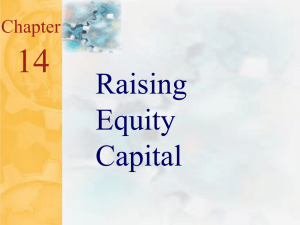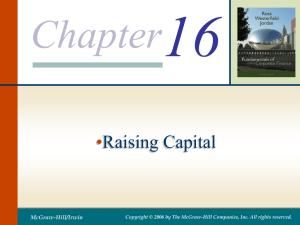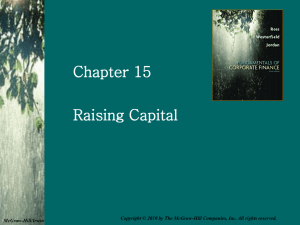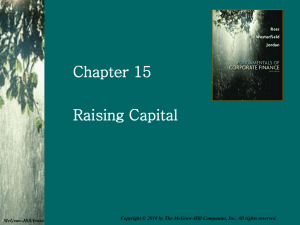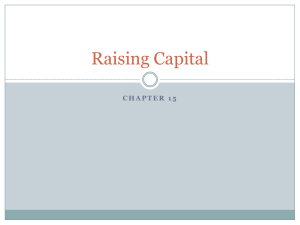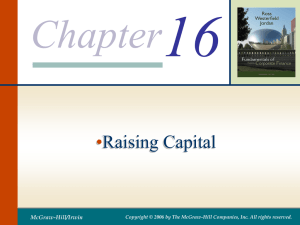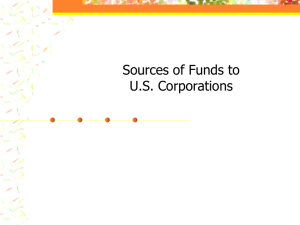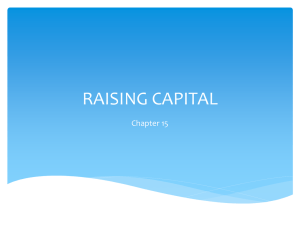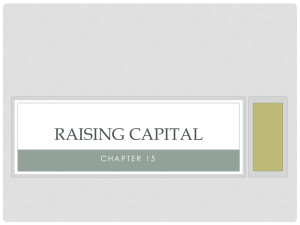Notes
advertisement
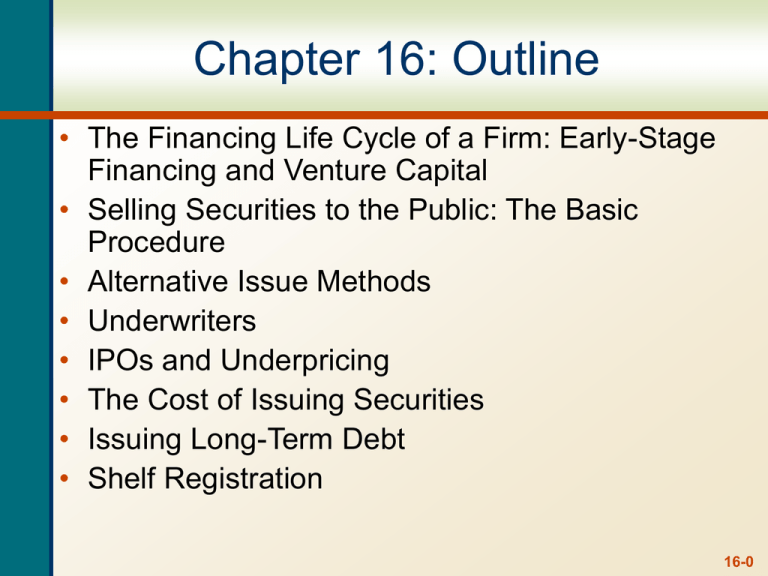
Chapter 16: Outline • The Financing Life Cycle of a Firm: Early-Stage Financing and Venture Capital • Selling Securities to the Public: The Basic Procedure • Alternative Issue Methods • Underwriters • IPOs and Underpricing • The Cost of Issuing Securities • Issuing Long-Term Debt • Shelf Registration 16-0 Venture Capital • Private financing for relatively new businesses in exchange for stock • Usually entails some hands-on guidance • The company should have an “exit” strategy • Sell the company – VC benefits from proceeds from sale • Take the company public – VC benefits from IPO • Many VC firms are formed from a group of investors that pool capital and then have partners in the firm decide which companies will receive financing • Some large corporations have a VC division 16-1 Choosing a Venture Capitalist • Look for financial strength • Choose a VC that has a management style that is compatible with your own • Obtain and check references • What additional business contacts does the VC have? • What is the exit strategy? 16-2 Selling Securities to the Public • Management must obtain permission from the Board of Directors • Firm must file a registration statement with the SEC • SEC examines the registration during a 20-day waiting period • A preliminary prospectus, called a red herring, is distributed during the waiting period • If there are problems, the company is allowed to amend the registration and the waiting period starts over • Securities may not be sold during the waiting period • The price is determined on the effective date of the registration 16-3 Underwriters • Services provided by underwriters • • • • Formulate method used to issue securities Price the securities Sell the securities Price stabilization by lead underwriter • Syndicate – group of investment bankers that market the securities and share the risk associated with selling the issue • Spread – difference between what the syndicate pays the company and what the security sells for initially in the market 16-4 Firm Commitment Underwriting • Issuer sells entire issue to underwriting syndicate • The syndicate then resells the issue to the public • The underwriter makes money on the spread between the price paid to the issuer and the price received from investors when the stock is sold • The syndicate bears the risk of not being able to sell the entire issue for more than the cost • Most common type of underwriting in the United States 16-5 Best Efforts Underwriting • Underwriter must make their “best effort” to sell the securities at an agreed-upon offering price • The company bears the risk of the issue not being sold • The offer may be pulled if there is not enough interest at the offer price and the company does not get the capital and they have still incurred substantial flotation costs • Not as common as it used to be 16-6 Dutch Auction Underwriting • Underwriter accepts a series of bids that include number of shares and price per share • The price that everyone pays is the highest price that will result in all shares being sold • There is an incentive to bid high to make sure you get in on the auction but knowing that you will probably pay a lower price than you bid • The Treasury has used Dutch auctions for years • Google was the first large Dutch auction IPO 16-7 Green Shoes and Lockups • Green Shoe provision • Allows the syndicate to purchase an additional 15% of the issue from the issuer • Allows the issue to be oversubscribed • Provides some protection for the underwriters as they perform their price stabilization function • Lockup agreements • Restriction on insiders that prevents them from selling their shares of an IPO for a specified time period • The lockup period is commonly 180 days • The stock price tends to drop when the lockup period expires due to market anticipation of additional shares hitting the street 16-8 IPO Underpricing • Initial Public Offering – IPO • May be difficult to price an IPO because there isn’t a current market price available • Private companies tend to have more asymmetric information than companies that are already publicly traded • Underwriters want to ensure that, on average, their clients earn a good return on IPOs • Underpricing causes the issuer to “leave money on the table” 16-9 Figure 16.2 16-10 Figure 16.3 16-11 Equity Issues and Price • Stock prices tend to decline when new seasoned equity is issued • A possible explanation for this phenomenon • Signaling and managerial information • Since the drop in price can be significant and much of the drop may be attributable to negative signals, it is important for management to understand the signals that are being sent and try to reduce the effect when possible 16-12 Issuance Costs • Spread • Other direct expenses – legal fees, filing fees, etc. • Indirect expenses – opportunity costs, i.e., management time spent working on issue • Abnormal returns – price drop on existing stock • Underpricing – below market issue price on IPOs • Green Shoe option – cost of additional shares that the syndicate can purchase after the issue has gone to market 16-13 Rights Offerings: Basic Concepts • Issue of common stock offered to existing shareholders • Allows current shareholders to avoid the dilution that can occur with a new stock issue • “Rights” are given to the shareholders • Specify number of shares that can be purchased • Specify purchase price • Specify time frame • Rights may be traded OTC or on an exchange 16-14 Dilution • Dilution is a loss in value for existing shareholders • Percentage ownership – shares sold to the general public without a rights offering • Book value and EPS – occurs when marketto-book value is less than one 16-15 Types of Long-term Debt • Bonds – public issue of long-term debt • Private issues • Term loans • Direct business loans from commercial banks, insurance companies, etc. • Maturities 1 – 5 years • Repayable during life of the loan • Private placements • Similar to term loans with longer maturity • Easier to renegotiate than public issues • Lower costs than public issues 16-16 Shelf Registration • Permits a corporation to register a large issue with the SEC and sell it in small portions • Reduces the flotation costs of registration • Allows the company more flexibility to raise money quickly • Requirements • Company must be rated investment grade • Cannot have defaulted on debt within last three years • Market value of stock must be greater than $150 million • No violations of the Securities Act of 1934 in the last three years 16-17
